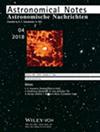Preliminary Study on Monitoring Local Atomic Clocks Using Millisecond Pulsars
Abstract
UTC(k) can be considered a shorthand for the local time standard maintained by a country's or region's time- frequency laboratory. Each lab uses its local atomic clocks to maintain this standard and synchronizes it with Coordinated Universal Time (UTC). Although local atomic clocks can operate independently, they generally rely on UTC as a reference standard for precision and long-term stability. To effectively monitor local atomic clocks and improve monitoring efficiency, this paper aims to study new monitoring methods from the perspective of macroscopic astrometry. By utilizing the measurement results of millisecond pulsars and combining them with clock models, this paper focuses on calculating and predicting the deviation data of local atomic clocks. This method not only expands the means of monitoring local atomic clocks but also has significant implications for improving monitoring accuracy and reliability. To validate its effectiveness, we first calculate and analyze the actual and simulated data of millisecond pulsars, then compare the analysis results with the conventional clock deviation data of local clocks based on UTC as a reference. The results indicate that using millisecond pulsars for monitoring can feasibly obtain the phase and frequency deviations of local atomic clocks within a 95% confidence interval. This demonstrates the feasibility of this method. Therefore, monitoring local atomic clocks using millisecond pulsars is reliable and effective. This study provides new insights and methods for the monitoring of local clocks and is significant for improving monitoring accuracy and reliability.


 求助内容:
求助内容: 应助结果提醒方式:
应助结果提醒方式:


